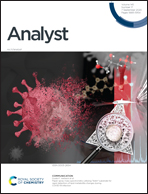Ultra-fast detection and quantification of nucleic acids by amplification-free fluorescence assay†
Abstract
Two types of clinically important nucleic acid biomarkers, microRNA (miRNA) and circulating tumor DNA (ctDNA) were detected and quantified from human serum using an amplification-free fluorescence hybridization assay. Specifically, miRNAs hsa-miR-223-3p and hsa-miR-486-5p with relevance for rheumatoid arthritis and cancer related mutations BRAF and KRAS of ctDNA were directly measured. The required oligonucleotide probes for the assay were rationally designed and synthesized through a novel “clickable” approach which is time and cost-effective. With no need for isolating nucleic acid components from serum, the fluoresence-based assay took only 1 hour. Detection and absolute quantification of targets was successfully achieved despite their notoriously low abundance, with a precision down to individual nucleotides. Obtained miRNA and ctDNA amounts showed overall a good correlation with current techniques. With appropriate probes, our novel assay and signal boosting approach could become a useful tool for point-of-care measuring other low abundance nucleic acid biomarkers.



 Please wait while we load your content...
Please wait while we load your content...